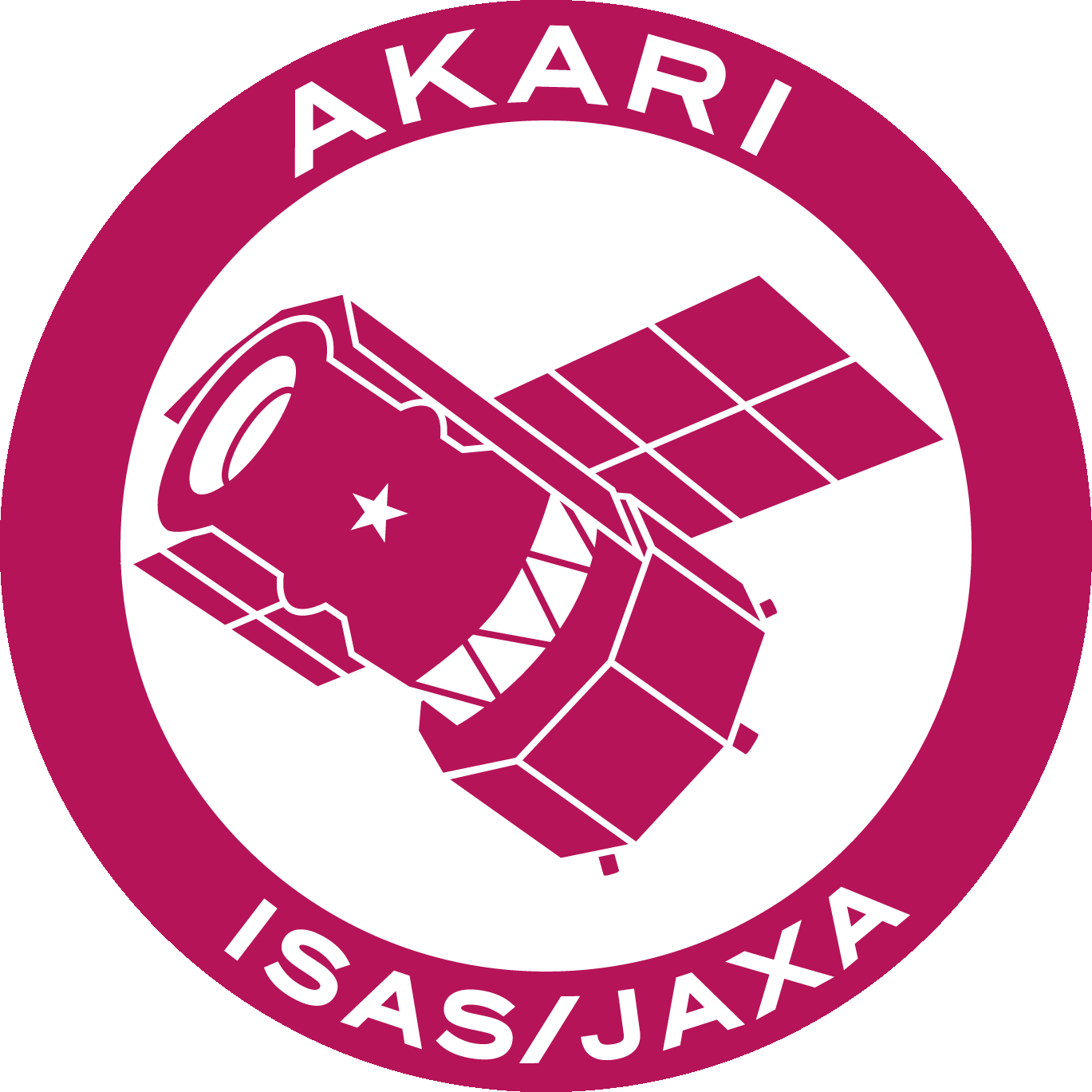Topics
After one year of observations; The Universe as seen by AKARI
Our Galaxy is disk shaped and exhibits a spiral structure of stars. However, the stars that we see in the visible images of our Galaxy represent only a fraction of the total material of our Milky Way. In addition there are copious amounts of cold gas and dust existing at temperatures below −200 °C. The distribution of this cold gas and dust is not uniform. High density regions gravitationally attract more and more matter from the surrounding regions, until eventually stars are formed.
The emission of the cold dust and gas is invisible to us when observed in normal light, however, this material instead emits at longer wavelength infrared light. Thus, observations of the sky in infrared light can tell us where and how this invisible gas and dust are distributed across the Galaxy. In the regions where stars are actively being formed, the dust is warmed up by the stellar light and also emits in infrared light. Therefore, by tracing this infrared emission we can search for and study the site of current active star formation in our Galaxy.
1. All-Sky Map at 9 micrometres
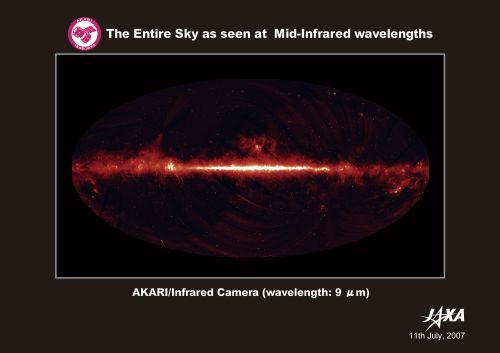
Figure 1: All-Sky Map at 9 micrometres
The AKARI mission is currently observing the entire sky in infrared light. This image is the All-Sky Map in the 9 micrometre wavelength range. The bright stripe seen running across the centre of the image from left to right is the disk of our own Galaxy (known as the Galactic Plane) looking from the Earth into the disk. The brightest region in the very centre of the image is towards the direction of the centre of our Galaxy. In this direction old, bright red stars crowd together adding their contribution to the infrared emission of our Galaxy in addition to that from the interstellar dust. We see several bright regions corresponding to strong infrared radiation along or next to the Galactic Plane. These regions are sites of newly born stars where we are viewing the radiation emitted from the heated dust. Note that Zodiacal emission component is crudely removed from this image.
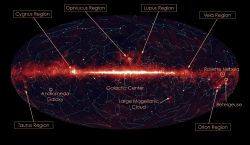
Figure 2: Constellations and major star forming regions on the Fig 1. (This image is produced by Nagoya City Science Museum using STELLER NAVIGATOR by AstroArts Inc.)
Nearby Galaxies and active Galactic star-forming regions appearing bright in the infrared are indicated on an identical image to Figure 1. The image tells us where in the Galaxy, stars are actively being formed. Further detailed analysis of the data used to make this image will be used to study the physical conditions of these star formation regions.
In particular, we point your attention to the object in lower-right area in the image, indicated as the "Large Magellanic Cloud". This object is in fact a galaxy that neighbours our very own Milky Way. The fact that the Large Magellanic Cloud also appears bright in the infrared implies that active star formation is also ongoing in this galaxy as well. Although they are not seen at the current resolution of this image, there are many such galaxies in the Universe undergoing active star formation. AKARI will also observe these galaxies to build up a comprehensive picture of the star formation history of the Universe.
2. The constellation Orion and the winter Milky Way at 140 micrometre
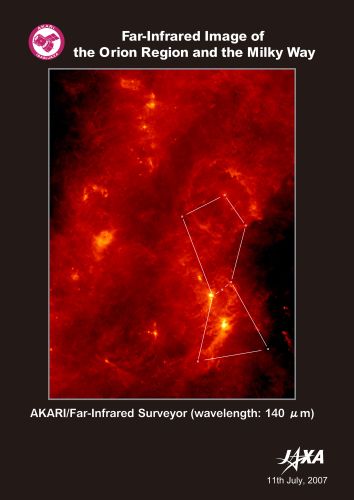
Figure 3: The constellation Orion and the winter Milky Way at 140 micrometre
This image covers a region of about 30×40 square degrees and includes the constellation Orion. Such a large regional image to high resolution at wavelengths beyond 100 micron is only realistically possible with an All-Sky Survey mission like AKARI. Such a survey may not be carried out again for many many years to come.
The right half of the image covers the constellation Orion, while the left side is the Monoceros. The Galactic Plane is located from the top to bottom in the left side of the image. Cold dust in the Galactic Plane appears as diffuse radiation over the entire image.
The very bright source just below the belt of Orion is the famous Orion Nebula (M42). Many stars are being born in this nebula, and the dust heated up by these stars emits very strongly in infrared light. The bright object on the left side of Orion's belt is another major star forming region which includes the Horse Head nebula. In contrast to its appearance as a dark cloud in visible light, it is extremely bright in the infrared. The bright extended emission seen in the middle-left part of the image is the so called Rosette Nebula, yet another star forming region. Finally, the big circular structure centred at the head of Orion is clearly visible. Presumably many heavy stars were formed at the centre of the circle, Causing a corresponding series of supernova explosions that has swept out the dust and gas in the region forming a shell-like structure.
The Orion Nebula is located about 1500 light years away from the Earth and the Rosetta nebula is at a distance of 3600 light years.
3. Star forming region in the constellation Cygnus
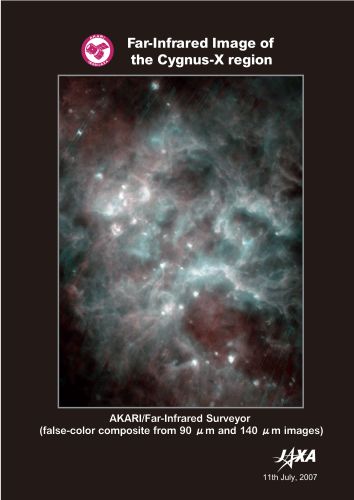
Figure 3: Star forming region in the constellation Cygnus. (False colour composite from images at 90 and 140 micrometre)
An infrared image of the "Cygnus-X" region taken by AKARI. The image covers 7.6 × 10.0 square degree region in the constellation Cygnus. This region is in a direction along the so called "Orion arm", one of the spiral arms in our Galaxy. Many objects at distances of 3000–10000 light years are projected on this small region. We see the Galactic plane from the top-left to bottom-right.
The many bright spots in the image reveal regions where new stars are being born. They heat up the dust and ionize the gas in their vicinity producing strong infrared radiation. There are only a small number of regions in our Galaxy that exhibit so many massive star forming regions over such a restricted area of the sky. Large, dark hollows are also clearly visible on the image. They are created by clusters of massive, high-temperature stars, that have blow away the surrounding gas and dust by their strong radiation. Note that a similar structure was also shown previously in the image of IC 1396, presented in an earlier AKARI Gallery.
ISAS TopicsMaterials
- Figure 1 (© JAXA)
- Figure 2 (© JAXA)
- Figure 3 (© JAXA)
- Figure 4 (© JAXA)


